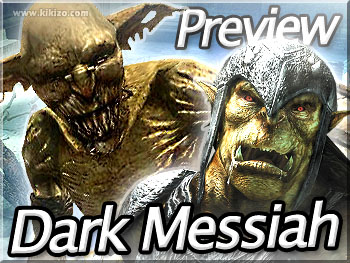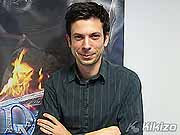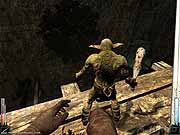Preview: Dark Messiah of Might & Magic
It's like Half-Life 2, but with Source-powered swords instead of plasma guns - and it's a big deal, as Ubisoft explains to Kikizo. We think it's destined for console, too.
Page: 1 2
At a special 'crypt' location last week, Ubisoft invited us to see and play all-new singleplayer, and multiplayer action from one of its most promising upcoming releases, co-developed with France-based Arkane Studios and Kuju Entertainment in the UK, as well as Half-Life makers Valve. The flicker of candles lighting the dusty, beautiful old venue was a fitting location for the medieval backdrop of Dark Messiah of Might and Magic, which is looking rather splendid thanks to sharing the same celebrated game engine as Half-Life 2.

While the game has a similarly crisp, physical and realistic look to Half-Life 2: Episode 2 - complete with the 'high dynamic range' lighting sexiness of the Valve follow-up - the similarities pretty much end there. Your crowbar is replaced with the swords, spells and mythology of the Might and Magic universe - fresh from its fifth Heroes of Might and Magic outing.
Ubisoft wants to show fans that the best is yet to come, and it's taking a lot of creative care to get there. "We got this beautiful brand from 3DO, but they made a lot of games individually that were not always coherent from one title to the next," explains Ubisoft producer Romain de Waubert de Genlis in an interview with Kikizo at the event. "That's something we wanted to stop, and to take the universe forward we wanted to make sure we'd have consistency for the games we're working on. We got a lot of stuff from the previous games, and we're building on that - and on the heritage of the previous Heroes titles."
"Dark Messiah is our second M&M game following Heroes V - the two stories are linked, and the events of Dark Messiah occur twenty years after the events of Heroes. You won't see the same locations but some characters will be linked from one [game] to the next."
Environments in Dark Messiah are sprawling and varied, comprising undulating terrain, extravagant castle structures and murky dungeons; there's a city set on a steep ness and protected by huge walls, a small coastal market town, an ancient ruin surrounded by two abandoned temples, a coastal cliff scorched by a deep pit that guards the entrance to the 'undead' realm, and the gigantic undead necropolis, set in deep caves, guarded bottomless pits.
But the environment is always something that you have to use, as well. "You have challenges, but they are not like puzzles; it's not like there's this wall and you think, how do I get up there, take a crate, climb on top... no. If you want to find secret passages and stuff, playing around with different objects will help you out, but puzzles - not that I would call them puzzles - are more strategic."
 | |
| De Genlis: "It's all about passing a challenge in a smart way, not always just rushing in and killing people." | |
Players might also have a situation where in one area you have goblins, and elsewhere you have orcs - "they can't stand the living hell out of each other", as Romain puts it - so maybe you're going to go in the goblin room, create a fuss and have them run after you to the orcs, at which stage you can wait for them to kill each other and then finish off the survivors - sort of like a smart Big Brother contestant.
"We wanted to make sure that the right approach is rewarded; if you're a warrior and the only way to advance were to kill everyone, we don't want the warrior to gain more experience than the thief, who would sneak around and kill. It's all about passing a challenge in a smart way, and the smart way is not always rushing in and killing a lot of people."
With traps all over the place, dynamic environments, and four categories of weapon spanning 27 choices, there's already a lot of variety, but in our hands-on sessions it was the range of character classes that we found impressive. The Archer is the sniper, dedicated at dealing high damage on a single target; a Mage will provide artillery support with awesome magical weaponry that will deal huge radius damage at distance; the Priestess is either a devious enemy or a strong team support - she can cure or buff her team or harm, slow, poison and blind the enemy, while 'resurrection' lets her bring friends back from the dead, or eat the souls of enemies.
There's more - The Warrior has only one goal: get close, and kill fast, but has no ranged attacks; and an Assassin is lethal, silent, and sneaky, with the ability to become invisible thanks to his cloaking ability. However, he will become more visible the faster he moves.
Page: 1 2
| Video Coverage (Latest Videos & Video FAQ) | |||
| PLEASE DO NOT DIRECT LINK TO ANY MEDIA FILE ON KIKIZO | |||
| Description | Dur. | Size | Details |
| New Videos (8/10) | |||
|
Dark Messiah New gameplay video 1 |
1:45 | 64MB | DF, ED, 16:9 856x480p30 6Mbps |
|
Dark Messiah New gameplay video 2 |
1:23 | 43MB | DF, ED, 16:9 856x480p30 6Mbps |
|
Dark Messiah New gameplay video 3 |
1:23 | 46MB | DF, ED, 16:9 856x480p30 6Mbps |
|
Dark Messiah New gameplay video 4 |
3:15 | 83MB | DF, ED, 16:9 856x480p30 6Mbps |
| Recent Videos | |||
|
Dark Messiah Direct feed gameplay (PC - Ubisoft) |
00:45 | 16MB | DF, ED, 16:9 852x480p30 3.0Mbps |


















 Satoru Iwata Video Interview - the late Nintendo president spoke with Kikizo in 2004 as 'Nintendo Revolution' loomed.
Satoru Iwata Video Interview - the late Nintendo president spoke with Kikizo in 2004 as 'Nintendo Revolution' loomed. Kaz Hirai Video Interview - the first of Kikizo's interviews with the man who went on to become global head of Sony.
Kaz Hirai Video Interview - the first of Kikizo's interviews with the man who went on to become global head of Sony. Ed Fries Video Interview - one of Xbox's founders discusses an epic journey from Excel to Xbox.
Ed Fries Video Interview - one of Xbox's founders discusses an epic journey from Excel to Xbox. Yu Suzuki, the Kikizo Interview - we spend time with one of gaming's most revered creators.
Yu Suzuki, the Kikizo Interview - we spend time with one of gaming's most revered creators. Tetris - The Making of an Icon: Alexey Pajitnov and Henk Rogers reveal the fascinating story behind Tetris
Tetris - The Making of an Icon: Alexey Pajitnov and Henk Rogers reveal the fascinating story behind Tetris Rare founders, Chris and Tim Stamper - their only interview? Genuinely 'rare' sit down with founders of the legendary studio.
Rare founders, Chris and Tim Stamper - their only interview? Genuinely 'rare' sit down with founders of the legendary studio. The History of First-Person Shooters - a retrospective, from Maze War to Modern Warfare
The History of First-Person Shooters - a retrospective, from Maze War to Modern Warfare